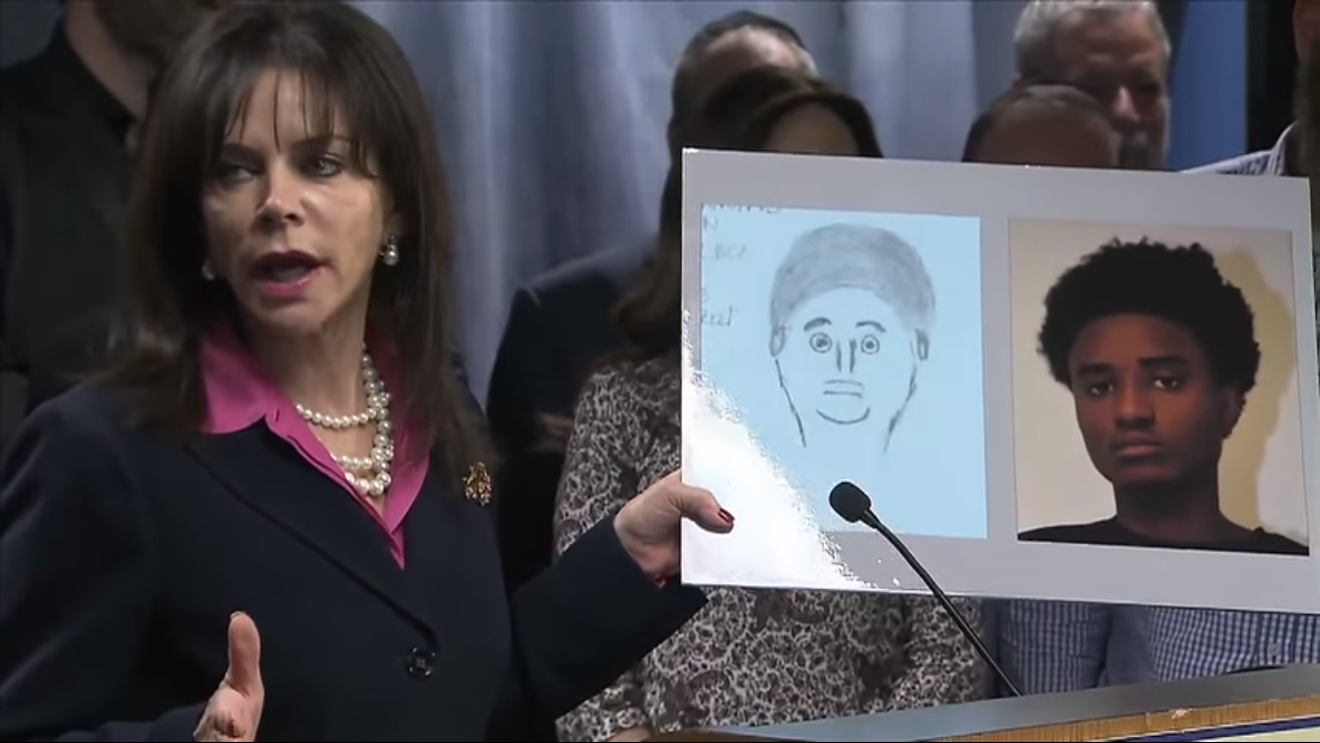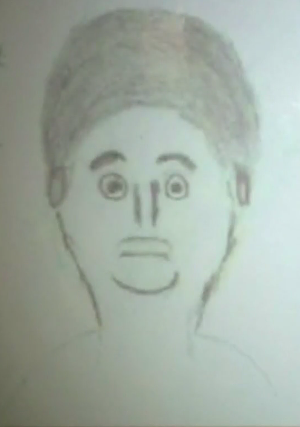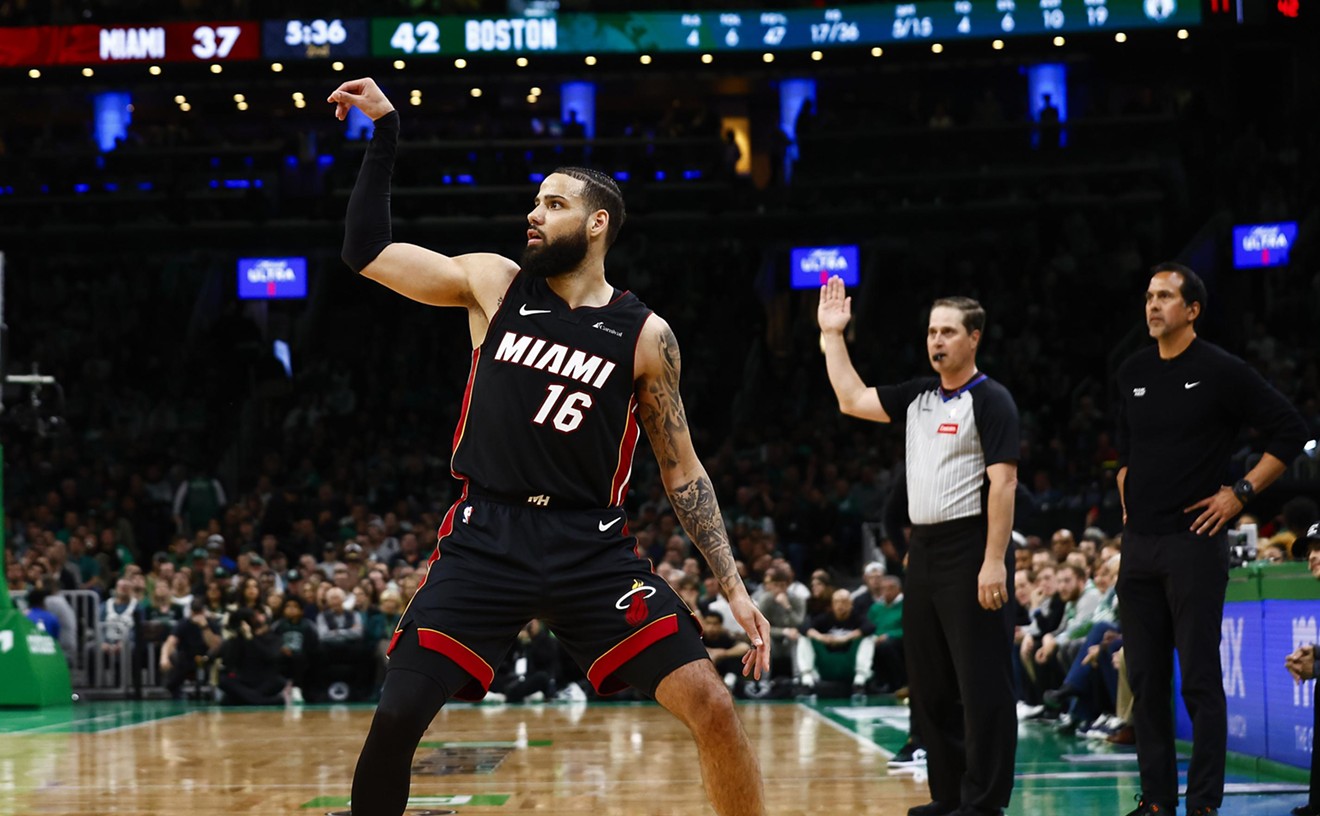The case is one of the biggest black eyes in the history of the Miami-Dade Police Department and State Attorney Katherine Fernandez Rundle's administration. In 2015, local cops, elected officials, and Rundle stood at a lectern and declared that then-15-year-old Deandre Charles had murdered Joseph Raksin, a prominent New York City rabbi. Rundle then revealed an utterly ridiculous witness-drawn sketch that looked more like a discarded Muppet than a human being.
But roughly a year later, prosecutors were forced to admit Charles didn't kill the rabbi. In an explosive lawsuit filed in federal court last Thursday, Charles' lawyers say they now have proof that both Rundle's office and the detective involved, Michael Brajdic, possessed evidence from the beginning that proved Charles' innocence. Yet they charged the teen anyway and plastered his face on TV next to the humiliating sketch that later went so viral it became part of a Kevin Hart comedy routine.
In short, the suit alleges the county could have (and should have) avoided ruining the life of an innocent 15-year-old by labeling him a murderer. According to the suit, Brajdic, the police detective, had ample evidence that a group of young men was involved in the killing. He was repeatedly told that Charles was home with his family when the homicide occurred.
In fact, Charles' family now says
But Brajdic and Rundle's office pushed the grand jury to indict Charles based on faulty DNA evidence and statements from the witness who drew the bad sketch.
"They held this event that looked like an old 'perp walk,'" Charles' lawyer, James DeMiles, tells New Times. "They had this poster-size picture of Deandre. They said they had this DNA, this great case against him, but they didn’t have it. There were members of Miami-Dade County onstage, members of Miami-Dade PD onstage. Then they whipped out that sketch that the witness drew that looked like a Sesame Street character. So my client gets ridiculed. He was the butt of jokes of Kevin Hart. He was internationally known.""Then they whipped out that sketch that the witness drew that looked like a Sesame Street character."
tweet this
Notably, the suit also states law enforcement obtained no new evidence in the case from the day cops arrested Charles until he was released 333 days later.
Neither prosecutors nor police responded to messages from New Times yesterday. Both agencies typically do not comment on active litigation.
If proven, the case would be another scathing indictment of both MDPD and Rundle, who has been the county's top prosecutor since 1993. She was the subject of international scorn after refusing to charge four prison guards involved in the death of Darren Rainey, a mentally ill man who was placed in a scalding-hot prison shower by guards who wanted to punish him. Rainey died in there. One guard who escaped charges, Roland Clarke, later became a Miami Gardens cop — Clarke has since been repeatedly accused of official misconduct and having sex while on duty. A Miami-Dade County medical examiner, Emma Lew, dubiously claimed Rainey had no burns on his body when he died. Rundle later recommended that Lew receive an award for her work.
Rundle's office also recently bungled DNA evidence in a different, cold-case murder: In 2014, prosecutors charged a man in a 1986 killing, but in August 2018, they quietly dropped the case in what was likely
Since prosecutors dropped Charles' case in 2017, no other suspects have been arrested in connection with the murder of Rabbi Raksin, who was fatally shot August 9, 2014, while he walked toward a temple in a heavily Jewish section of North Miami Beach. Some people initially questioned whether the murder was a hate crime, but it later began to seem more like a robbery gone awry. Raksin, who lived in New York City, was in town visiting relatives. After he was killed, hundreds of supporters gathered in Crown Heights, Brooklyn, to mourn his death.
The case remained open for 16 months. Then, in 2015, prosecutors became convinced that Charles, just 14 years old at the time of the murder, had tried to rob Raksin and then killed him after discovering he had no money. Rundle's office convened a grand jury, which ultimately indicted the boy.
Rundle and many high-ranking county employees then showed up for that infamous 2015 news conference.
“This is a prime example of how prosecutors and police can work together,” Rundle said from a lectern. She later added that Raksin "didn’t have any money on him," so Charles "shot and killed him."
Raksin's daughter painted Charles as a "vicious thug" who should have been "prosecuted to the fullest extent the law allows."
At the news conference, Rundle unveiled a sketch drawn by a murder witness. Multiple news outlets suggested it was the single worst facial composite sketch they had ever seen. It was a mix of borderline racism and Bert from Sesame Street.
During the press gathering, Rundle held the sketch next to a photo of Charles' face. The juxtaposition was somehow proof that she and her team had caught the killer.
Perhaps more important, Charles' family had said from day one that the teen was nowhere near the North Miami Beach temple when Raksin was shot. Blair Charles, the suspect's mother, told the media that her son was home when the murder occurred.
"All my kids were here on that Saturday," she told CBS Miami.
Another relative, Willis Archibald, confirmed Charles' alibi: "One hundred percent certain he didn’t do this. The whole family was home when this incident occurred.”
The new lawsuit appears to show that law-enforcement officials bizarrely pushed to indict the wrong suspect despite being told someone else had committed the crime. According to the legal complaint, both a confidential police informant and a civilian tipster identified the four men — listed as K.C., D.P., M.K., and J.S. in the lawsuit — as having been at the murder scene. The informants both said some members of the group had been driving around in a black Cadillac Escalade. The suit contends neither the informant nor the tipster mentioned Charles.
On August 15, 2014, two of the four men — K.C. and D.P — arrived at Charles' home and asked if the boy's older brother was around. The brother wasn't there. So the two men asked Charles if he wanted to take a ride in the Escalade. The suit says the teen was "wowed" by the luxury SUV and wanted to sit in it.
But during the joyride, cops stopped the vehicle. They detained all three and questioned them. The suit says K.C. and D.P. gave obviously inconsistent testimony about where they were when Raksin was killed. Neither man said Charles was with them the day of the murder.
At least two of the four men named by the informants have a history of armed robbery. One even openly admitted that his friend K.C. was a "known burglar and robber," the suit says.
Roughly a year later, law enforcement obtained even more evidence tying the four men to the slaying. Suspect J.S. had been arrested on unrelated charges. While in custody, he confirmed he and the three other men had been at the murder scene.
"The three men that J.S. identified and described as being involved in the murder of Rabbi Joseph Raksin were the same three men named by the confidential informant and two of the same three men named in the Crime Stoppers tips," the suit says. "J.S. did not mention the Plaintiff [Charles] as having any involvement in the attempted robbery and murder."
J.S. also admitted that the four regularly committed burglaries together and that the morning of the rabbi's death, they had been unsuccessfully trying to rob houses. J.S. then described what K.C. and D.P. were wearing that day — the suit says the description closely matched statements from eyewitnesses.
On October 1, 2015, a Miami-Dade County crime lab technician examined bullet casings taken from the murder scene. The tech said the casings closely matched those from an armed robbery that took place the day before Raksin's homicide. The suit says that K.C. was already a suspect in that robbery and that police did not suspect Charles had anything to do with that case."There was a difference here between a DNA match and just a probability of inclusion," DeMiles explains.
tweet this
"There was no explanation as to how the Plaintiff could have possibly obtained possession of the firearm following the armed robbery on August 8, 2014, for its use in the murder of Rabbi Joseph Raksin one day later on August 9, 2014," the suit states.
Charles' legal team also notes that, although K.C. was a good bit older than Charles, the two look somewhat alike, thus "causing the possibility of
So Charles' lawyer, DeMiles, tells New Times that Detective Brajdic relied on one witness statement — made from more than 100 feet away — and DNA evidence from the gun and Escalade to wrongfully name Charles as the killer. DeMiles adds that he believes Rundle's office then relied heavily on the single police detective's incorrect interpretation of the facts. In fact, DeMiles claims Brajdic and MDPD misinterpreted DNA evidence too.
"There was a difference here between a DNA match and just a probability of inclusion," DeMiles explains. "When you're talking about inclusion, you're talking about it being a probability of multiple people. What they thought might have been a gene linking the DNA to Deandre might have just been a gene for curly hair, for example."
After dropping Charles' case, the
Moreover, the police say they relied on cell-phone-tracking technology to link Charles to the murder scene, but, in fact, Charles didn't have his phone on him that day. Someone else did.
"This evidence was in the detective’s possession and control the whole time," DeMiles says. "I think the state attorney believed the detective, but the detective really dropped the ball." Charles ultimately sat in jail from December 2015 to November 2016 — 333 days. He was released on house arrest until January 2017.
"Now," DeMiles adds, "he's doing good, but he'll still be out places in public and people will look at him. He says he'll think, 'Am I getting this mean look because people think I’m a murderer?'"













